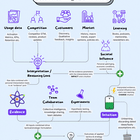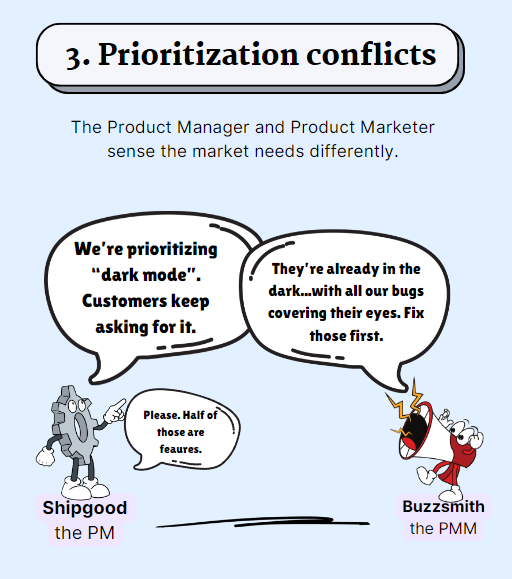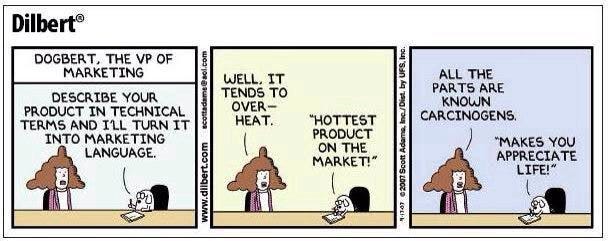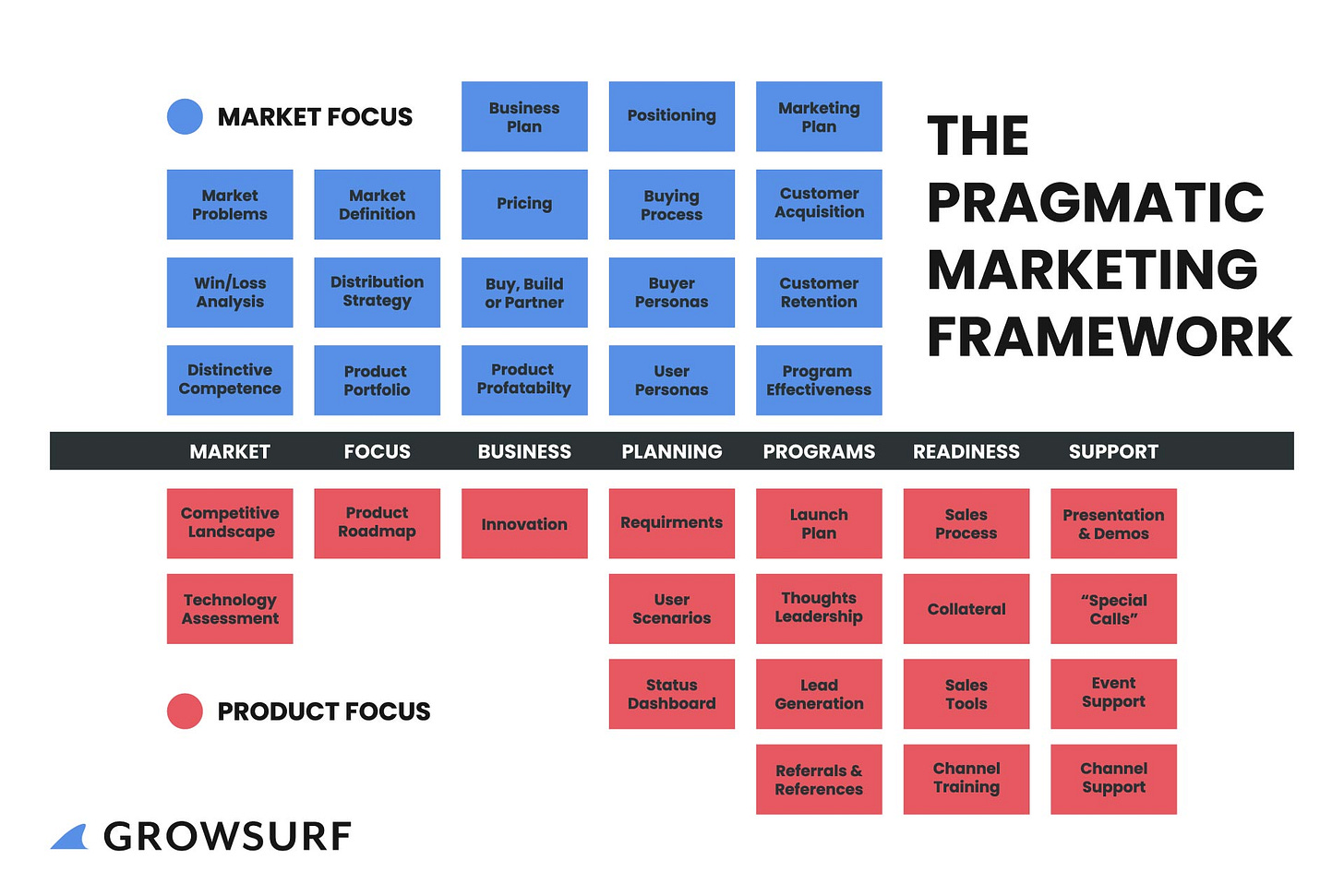"We won't be renewing this year."
Those were the scary words of a decision-maker at a large conglomerate to our CEO one fine afternoon.
It came as a surprise. The week prior, the customer success rep managing the account was confident about landing an expansion deal with them for our applicant tracking software.
And now this.
"May I inquire why?" inquired our CEO.
"We have ambitious hiring plans this year. Our HR software needs requisitions and onboarding modules, which your product doesn't provide. Thus, we're moving to [top competitor]."
The CEO was perplexed. As soon as he got off the call, he summoned the PM.
The PM confirmed they had already rolled out requisitions and onboarding for another customer a few quarters back.
The customer success rep was summoned.
The CS team had no clue. Their sales decks or demo collateral were never updated, and they didn't get formal product training.
The Product Marketer was summoned.
The PMM pleaded innocence, saying they hadn’t received any intimation about the feature release.
The blame game went in circles.
The CEO earnestly requested the customer for a short meeting with a PM to reconsider. They obliged.
The PM took 15 minutes to convince the customer of our features. We highlighted the needless transition cost they would have to undergo.
So, yes, we managed to save the account.
However, we unearthed a grave misalignment between PMs, PMMs, and customer-facing teams and how it could negatively impact the business.
When you search online, there isn’t much talk about challenges around the PM and PMM relationship. But that's not to say there aren't seething issues. They've just not made it to the mainstream forefront yet.
I expect this debate to become much more vocal in the age of AI. As time-to-ship starts to lower and production cycles become faster, there will be an increased focus on distribution and capturing attention, especially in red ocean markets.
After speaking to active PMs and PMs in the SaaS arena, I see a mix - from amicable settings where both get along just fine to tense relationships. However, I realized that most firms don’t prioritize improving the PM-PMM partnership. They accept the status quo without realizing how poorly they operate and what they’re leaving off the table.
So, in this edition, I’ll be discussing the following:
6 common friction points between PMs and PMMs
Few contributing factors behind these friction areas
Some recommended solutions to address these issues
This is a long one, so I’d recommend you check the full post out on aatir.substack.com.
Before we get into that,
Editions you might have missed
6 friction points between PMs and PMMs
Let’s begin exploring PMs' common complaints with PMMs and vice versa. I’m going to try to give you a balanced view of both sides of the story:
1) Conflict around the boundaries and ownership of each role
PMs and PMMs are famously known to have overlapping areas, which can also become a source of contention.
For example, who is responsible for customer discovery? PMs work on their discovery cycles with existing customers, while PMMs conduct market research and liaise with sales and customer success to learn more about active customer needs. However, in many cases, that intel isn’t shared or reconciled.
Also, who has the final say on product positioning, messaging, or feature prioritization? PMs and PMMs both want that authority to varying degrees, but ownership can be fuzzy.
Some PMMs try to push their agendas and actively influence roadmap items by filing work for engineers. For example, a PM told me how PMMs started working directly with engineers to tweak the product's self-service experience, quoting how critical it was for adoption goals. The PM felt it went a bit too far, and had to step in to control the backlog.
These challenges arise when there isn't clarity on the swimlanes each party is supposed to operate in.
2) Product marketers complain about not being a part of the product strategy and the roadmap
A constant complaint among PMMs is that they need a seat at the strategic table because they represent “the market's voice.” When they aren't included in critical conversations around strategy and roadmap, that lack of context makes it hard for them to shape an effective go-to-market strategy. Not surprisingly, PMMs feel sidelined when treated as a PR or social media service.
On the other hand, some PMs feel conversations get derailed needlessly when PMMs start throwing in divergent ideas. They tend to feel they lack understanding of feasibility and viability. For example, a SaaS PM (who chose to stay anonymous) shared with me:
“At my company, PMMs are often victims of recency bias and lobby innovative but impractical ideas from customers or leadership that they may have heard in the past week.”
3) Sudden changes to launch dates can make life difficult for Product Marketers
For PMMs, volatility around launch dates can be disconcerting.
The two scenarios that are commonly reported:
A PMM prepares all the launch activities for a feature that’s supposed to go live the next day, but out of the blue, something else gets prioritized, putting all the hard work on the back burner. What surprises PMMs is how everything up until that U-turn moved at breakneck speeds. This last-minute shift becomes more challenging to steer when co-marketing campaigns with partners are involved.
PMs roll out a feature without sufficient advance notice, and PMMs are rushed to make internal and external announcements, expecting the messaging to come naturally to them.
On the flip side, PMs feel PMMs don't understand how iterative product development works and how things can shift quickly. The leadership and the stakeholder matrix can be demanding, and priorities can change fast, so they feel PMMs need to bake risk mitigation measures into their launch plans and keep dates flexible.
Moreover, some PMMs expect too much from their PMs - trying to involve them in demos, webinars, and content reviews. PMs are busy people, though. There's a limit to how many balls they can juggle.
4) PMs find PMMs miss the point by focusing on hype and jargon-filled messaging
PMs and PMMs don't always see eye to eye on messaging.
I used to think PMs were the ones who were usually shamed by engineers for not being "technical" enough. Some PMs feel PMMs are even further down the “technical know-how chain”.
The allegation is that PMMs use performative jargon in their messaging and copy, which can lead to misaligned expectations or overselling of certain features. This can come back to bite PMs and dev teams after the sale (especially in B2B SaaS), as customers feel deceived. For example, a “rule-based” feature might be called "AI-powered" or an API, an "open-source model.”
The overuse of terms like “revolutionary,” “streamline,” “supercharge,” “transformative,” and “boost ROI” doesn’t help either.
PMMs, however, feel PMs fail to share more context about what they're building.
They work in a black-box model and expect PMMs to promote features without the necessary context. Even when they do open up, they focus on “features” but not the use case, "story," or reasoning behind them. Funnily enough, sometimes PMs blame PMMs for the same thing.
5) Product managers and Product marketers thinking about the ICP in different ways
This stems from how PMs and PMMs think about their target audience.
PMMs work alongside sales and customer success, and their research is centered on demographics and firmographics, married with pain points. They also like to consider beachhead segments and the buying committee.
PMs build personas based on how primary end users and their use cases, and not around the decision-makers who will sign on the dotted line.
For example, in a product I led in the past, the PMs focused on building value for the recruiter and job seeker as the primary persona. However, none of those were decision-makers.
PMMs, on the other hand, favored the Director of HR and talent acquisition prospects. This is the classic "the buyer isn't the user" dilemma, which can create clashes in the target audience and go-to-market strategy.
Similarly, some PMs feel their product enables a wide range of use cases, and PMMs should cast a wide net. However, PMMs want to focus on specificity and target one segment at a time.
6) Product managers and marketers aren’t aligned on the importance of features and the launch intensity they deserve.
PMMs can over-amplify a feature that PMs think was a minor update by giving it more airtime than it needs. Or PMMs might undersell a module that PMs felt was a critical competitive differentiator and needed more eyeballs.
Thus, there are clashes between the intensity of launches, the go-to-market strategy, and even pricing tiers.
On the one hand, PMMs feel they don't get much support for the GTM campaign from product and engineering, while on the other, PMs feel PMMs miss the target of selecting the right level of promotion for each feature.
Imagine if, upon the release of “huddles” by Slack - a critical retention feature - the PMMs only chose to announce it via a product update email. PMs would rightly be flabbergasted.
Before we move on, I’d like your opinion on one matter:
Factors that contribute to this PM and PMM disconnect
Here’s what I’ve observed:
1) Factor: The department PMMs sit under.
If PMMs are part of the marketing department, there is a more significant communication gap with product teams. They are seen as a separate work stream, and collaboration isn’t very fluid. However, by remaining close to the marketing channels, PMMs enjoy much more leverage with content and go-to-market execution.
When PMMs sit under product OR when they are put up in squads or tribes, there tends to be better synergy. Of course, problems can still emerge, but the severity isn’t as bad as the parties are talking to each other on a regular basis.
2) Factor: The go-to-market motion they are running (product-led vs. sales-led)
With product-led growth, product marketing teams feel they have a better chance for impact through the product flows, so they naturally connect with PMs a lot more. The problem that arises here is contention for engineering bandwidth.
However, with sales-led growth teams, sales and marketing have many more demands from PMMs (e.g., battle cards and sales enablement), and they naturally align with them. This widens the gap between PMs and PMMs.
3) The background of the person where the reporting hierarchy of PMs and PMMs converges into
If the reporting structure ladders up to the CPO, there is better synergy between PMs and PMMs, as CPOs are generally adept at assessing the wider picture and end-to-end cycle.
However, if it ladders up to the CEO, it depends on their “background”.
Sales-centric CEOs will focus more on creating marketing noise for lead generation and give PMMs more leeway to impart influence. The roadmap will be infested with sales-driven requests that PMMs will be brokering.
Tech-centric CEOs who don't understand marketing or see it as a cost center tend to provide perfunctory support. They will side with product/engineering processes and the goal of shipping fast—at the expense of structured marketing initiatives.
4) Lack of understanding of the PMM role
The PMM is a relatively newer function, and many organizations, especially those moving away from top-down hierarchies, don't understand how to use it. Many still conflate it with traditional marketing. In lean teams or startups, PMMs double as digital marketers and product marketers out of necessity. The importance of messaging and positioning is rarely appreciated and seen as “fluff”.
Moreover, sales teams relegate PMMs to ATMs for slide decks and collateral. This lack of education about the PMM's role creates further friction and strains their relationships, especially the ones they have with PMs.
5) Misaligned incentive structures
PMs are incentivized on delivery (in feature factory settings) or product metrics like activation, paid conversions, engagement, or NPS.
PMMs, especially those that sit in marketing, are incentivized to generate leads and accelerate pipelines.
With such disparate North Stars, there is little motivation for PMs and PMMs to collaborate closely.
How do you resolve these issues?
In my humble view, here are some ideas that PMs and PMMs need to try out:
1) Conduct a workshop to understand the roles
PMs and PMMs must invest energy in understanding each other’s roles and limitations.
I’ve seen PMs who don't know much about a go-to-market strategy or the significance of positioning or messaging.
Similarly, PMMs intentionally remain at arm’s length from the technical intricacies of product development, the challenge of tech debt, or the stakeholder matrix PMs are buried under.
This fundamental understanding of each other’s roles (and associated concepts) might give a more profound sense of appreciation.
2) Demarcate the swimlanes
Work together to identify areas each party owns and what will remain a collaborative endeavor (e.g., launches).
One way to administer this would be to use the Pragmatic framework table and mark the boxes based on who owns and leads the activity. The keyword here is “lead”. Both PMs and PMMs should still contribute their input.
For every endeavor, one person needs to call the final shot. The direct supervisor of both teams should broker this conversation.
In my view, I lean towards this division of labor:
- PMs own the product strategy, roadmap, and feature prioritization.
- PMMs own the messaging, positioning, and go-to-market strategy.
Both can put forward their opinion, but one takes the conclusive call.
3) Change the definition of shipping
Product teams shouldn’t consider “code on production” as the final goal.
Shipping should be associated with the initial adoption of a product rather than delivery.
This will necessitate a goal set for every launch that factors into each party's OKRs, e.g. feature adoption or new acquisition. Aligning incentives in some capacity is crucial for the two parties to play in tandem.
4) Introduce PMMs earlier in the process & sync regularly
PMMs are often rushed because they are brought in too late in the product process, usually after the feature is already in production or about to ship.
PMMs should get involved when the solution is conceived and before the sprint is planned. They need to understand several contextual areas so that they can get an early bird's view of how the fairway will read in the future weeks.
Moreover, PMMs should remain in regular communication through weekly planning sessions, get access to the requisite JIRA boards, and be in the right Slack channels to anticipate launch date shift risks if re-prioritization conversations are brewing.
By working closely with PMs, PMMs can then develop more modular campaigns that can be executed in phases (rather than going all gung-ho on Day 1) and can be adjusted in time. Riskier marketing items (like co-partnerships) can pushed out in secondary phases.
PMMs should also, by default, inject buffer periods and plan for multiple launch scenarios, especially if it’s a tier 1 launch involving multiple components.
5) Co-piloted Win/Loss sessions
To create empathy, PMs need to realize how the product impacts real business. PMMs should lead sessions to discuss why specific deals were lost to competitors or due to product deficiencies and quantify that impact in dollar terms.
In my experience, listening to exit interview calls or snippets from our sales transcription tool together has birthed several meaningful conversations. It just seems a lot more authentic that way.
The danger here is over-indexing on losing one particular customer and overreacting too heavily. That’s why it should also involve sales and product heads so that they can guardrail the action steps.
Sometimes, these meetings do happen but fall on deaf ears. PMs and PMMs would need to hold each other accountable.
6) Co-owning internal evangelism
Finally, the most significant missed opportunity is the internal promotion of features.
If PMs and PMMs work on co-led product town halls, they can tag-team and excite the company about a feature.
They should promote built features to the leadership and sales/customer success teams together to push the product updates to their customers with conviction. It’s a brainless win-win as both parties want their work to move the needless. Sadly, many product teams walk away to building “the next big thing” after the code is shipped.
Hopefully, this edition gave you a sense of the PM and PMM relationship.
The key takeaways:
PMs and PMMs are often misaligned in several areas, such as personas, go-to-market strategy, messaging, and discovery.
The default case most teams slip into is the mentality that “PMs put stuff on the shelf; PMMs help get it off the shelf.” This deepens the silo by making it seem PMs and PMMs work sequentially and not collaboratively.
A contributing factor to this divide is an insufficient understanding of each other's roles and no actual activity around creating role boundaries.
Instead of seeing each other as a burden, PMs and PMMs must be paired to amplify each other’s impact. They need to work in lockstep throughout the product development cycle, figure out ownership, and partner closely on internal evangelism.
Curious - what's your take and opinion on this?
Till next time,
Aatir














